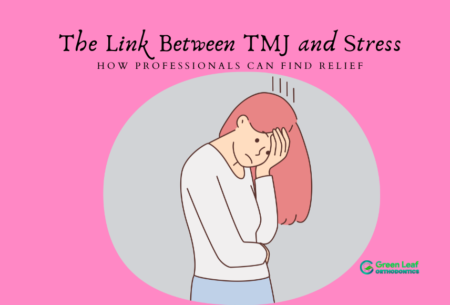
Understanding TMJ Disorders: Causes, Symptoms, and Treatment Options
Temporomandibular Joint (TMJ) disorders can significantly impact your quality of life, affecting everything from eating to speaking. At Greenleaf Orthodontics, located in Burlington, WI, and Park City, IL, we understand the importance of addressing TMJ disorders effectively. This blog will explore the causes, symptoms, and treatment options for TMJ disorders, helping you make informed decisions about your oral health.
What is TMJ Disorder?
The Temporomandibular Joint (TMJ) connects your jawbone to your skull, allowing for the movement necessary for chewing, talking, and yawning. When this joint is misaligned or stressed, it can lead to a range of issues collectively known as TMJ disorders. These disorders are often painful and can affect the muscles and ligaments surrounding the joint, making everyday activities challenging.
Causes of TMJ Disorders
Several factors can contribute to the development of TMJ disorders, including:
- Teeth Grinding (Bruxism): Grinding or clenching your teeth, especially during sleep, can put excessive pressure on the TMJ, leading to inflammation and discomfort.
- Jaw Misalignment: Misaligned teeth or an uneven bite can cause the jaw to move out of its natural position, straining the TMJ.
- Injury or Trauma: A direct blow to the jaw or face can damage the TMJ, leading to pain and limited movement.
- Arthritis: Conditions like osteoarthritis or rheumatoid arthritis can affect the TMJ, causing pain and inflammation.
- Stress: High levels of stress can lead to muscle tension in the jaw, exacerbating TMJ symptoms.
- Poor Posture: Poor posture, especially when sitting or standing for long periods, can contribute to TMJ disorders by affecting the alignment of your spine and jaw.
Common Symptoms of TMJ Disorders
Recognizing the symptoms of TMJ disorders is crucial for seeking timely treatment. Some common symptoms include:
- Jaw Pain or Tenderness: Persistent pain or tenderness in the jaw, especially when chewing or speaking, is a common sign of TMJ disorders.
- Clicking or Popping Sounds: If you hear clicking or popping sounds when you open or close your mouth, it may indicate a problem with the TMJ.
- Limited Jaw Movement: Difficulty opening or closing your mouth fully, or a sensation of the jaw “locking” in place, can be a symptom of TMJ disorders.
- Ear Pain or Tinnitus: TMJ disorders can cause pain in and around the ears, as well as ringing in the ears (tinnitus).
- Headaches: Frequent headaches, especially those that start near the temples, can be associated with TMJ disorders.
- Facial Pain: Pain that radiates across the face, particularly around the jaw, cheeks, or eyes, may be linked to TMJ disorders.
Treatment Options for TMJ Disorders
At Greenleaf Orthodontics, we offer a range of treatment options to manage TMJ disorders effectively. The right treatment plan will depend on the severity of your symptoms and the underlying cause of the disorder.
- Lifestyle Modifications:
- Stress Management: Since stress is a common trigger for TMJ disorders, learning relaxation techniques such as deep breathing exercises or meditation can help reduce muscle tension in the jaw.
- Dietary Changes: Avoiding hard, chewy, or sticky foods can minimize strain on the TMJ. Soft foods like yogurt, mashed potatoes, and soups are easier on the jaw.
- Posture Correction: Improving your posture, especially when sitting at a desk or using electronic devices, can alleviate TMJ symptoms. Keep your head aligned with your spine, and avoid leaning forward or slouching.
- Oral Appliances:
- Mouthguards: A custom-made mouthguard can protect your teeth from grinding and clenching during sleep, reducing pressure on the TMJ.
- Splints: Dental splints, which are worn over the teeth, can help realign the jaw and alleviate TMJ symptoms. These devices are particularly useful for those with jaw misalignment or uneven bites.
- Physical Therapy:
- Exercises: A physical therapist can teach you specific exercises to strengthen the jaw muscles and improve joint function. These exercises can help relieve pain and restore normal jaw movement.
- Massage: Gentle massage of the jaw muscles can reduce tension and improve blood flow to the area, promoting healing.
- Medications:
- Pain Relievers: Over-the-counter pain relievers like ibuprofen or acetaminophen can help manage TMJ pain and reduce inflammation.
- Muscle Relaxants: In cases of severe muscle tension, muscle relaxants may be prescribed to help ease jaw pain.
- Anti-Inflammatory Drugs: Nonsteroidal anti-inflammatory drugs (NSAIDs) can be effective in reducing inflammation and relieving pain associated with TMJ disorders.
- Orthodontic Treatment:
- Braces or Aligners: If jaw misalignment is contributing to your TMJ disorder, orthodontic treatment such as braces or clear aligners can help correct the alignment of your teeth and jaw. This can alleviate TMJ symptoms by reducing strain on the joint.
- Bite Adjustment: In some cases, minor adjustments to the bite can relieve pressure on the TMJ and reduce symptoms. This may involve reshaping the teeth or using dental restorations to improve the alignment of the bite.
- Surgical Options:
- Arthroscopy: For severe cases of TMJ disorders that do not respond to conservative treatments, minimally invasive arthroscopic surgery may be recommended. This procedure involves the use of a small camera and instruments to repair or remove damaged tissue in the joint.
- Open-Joint Surgery: In rare cases, open-joint surgery may be necessary to correct structural problems within the TMJ. This procedure is usually reserved for severe cases where other treatments have failed.
TMJ disorders can be painful and disruptive, but with the right treatment, relief is possible. At Greenleaf Orthodontics, we are committed to helping our patients find effective solutions for their TMJ issues. Whether you’re experiencing mild discomfort or severe symptoms, our team can guide you through the best treatment options to restore your oral health and improve your quality of life.
For more information or to schedule a consultation, contact Greenleaf Orthodontics at greenleaforthodontics@gmail.
#clearbracesingurnee #metalbracesinnorthchicago #crookedteethingurnee #overbiteinwaukegan #underbiteinwaukegan #invisiblebracesingurnee #TMJinhighlandpark #dentistthatacceptsforwardhealthinkenosha #bracketsdentalesmetálicosenwaukegan #bracketsdentalesestéticosenwaukegan #dienteschuecosenwaukegan #alineadoresenwaukegan #dentistaqueaceptaMedicaidenwaukegan #dentistaqueaceptaForwardHealthenracine #teethwhiteninghighlandpark



